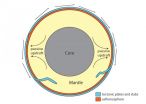How strong do you think you are?
British studies shine light on how strength changes across life
2014-12-04
(Press-News.org) Researchers from the Medical Research Council Lifecourse Epidemiology Unit (MRC LEU), University of Southampton have shed new light on how grip strength changes across the lifespan. Previous work has shown that people with weaker grip strength in midlife and early old age are more likely to develop problems, such as loss of independence and to have shorter life expectancy. However, there is little information on what might be considered a normal grip strength at different ages.
This latest research, which combined information from 12 British studies and is published in PLOS ONE, included grip strength readings from 49,964 participants aged from four years old to 90 and above, and combined them to produce reference charts.
Lead author, Dr Richard Dodds, Wellcome Trust Research Training Fellow at the MRC LEU at the University of Southampton, comments: "We found that men were typically stronger than women from adolescence onwards, but both men and women reached a peak level of strength during their thirties before becoming weaker with age. We are now clear about the range of normal strength in young adults and have used this information to propose levels below which an older person would be considered to have weak grip strength."
GPs or hospital doctors could use the information in this study to help interpret measurements of grip strength and to identify those at risk of frailty and loss of independence.
Avan Aihie Sayer, Professor of Geriatric Medicine, at the MRC LEU at the University of Southampton, who oversaw this work, adds: "Sarcopenia, the loss of skeletal muscle mass and function with age, is an area of intense research activity and is being increasingly recognised in clinical practice. Grip strength has been recommended for the assessment of muscle strength in the clinical setting and this study will aid the recognition of important conditions such as sarcopenia and frailty."
Cyrus Cooper, Professor of Rheumatology and Director of the MRC LEU at the University of Southampton where the research was carried out, adds: "This study forms part of a larger programme of research at the MRC Lifecourse Epidemiology Unit at the University of Southampton. Three of the twelve studies are based here at the Unit where one of our aims is to understand the causes across the lifecourse of common musculoskeletal conditions, including sarcopenia."
INFORMATION:
ELSE PRESS RELEASES FROM THIS DATE:
2014-12-04
An international team, including scientists from DESY, has caught a light sensitive biomolecule at work with an X-ray laser. The study proves that X-ray lasers can capture the fast dynamics of biomolecules in ultra slow-motion, as the scientists led by Prof. Marius Schmidt from the University of Wisconsin-Milwaukee write in the journal Science. "Our study paves the way for movies from the nano world with atomic spatial resolution and ultrafast temporal resolution", says Schmidt.
The researchers used the photoactive yellow protein (PYP) as a model system. PYP is a receptor ...
2014-12-04
The temperature of the seawater around Antarctica is rising according to new research from the University of East Anglia.
New research published today in the journal Science shows how shallow shelf seas of West Antarctica have warmed over the last 50 years.
The international research team say that this has accelerated the melting and sliding of glaciers in the area, and that there is no indication that this trend will reverse.
It also reveals that other Antarctic areas, which have not yet started to melt, could experience melting for the first time with consequences ...
2014-12-04
CORVALLIS, Ore. - Scientists may have solved a long-standing enigma known as the African Humid Period - an intense increase in cumulative rainfall in parts of Africa that began after a long dry spell following the end of the last ice age and lasting nearly 10,000 years.
In a new study published this week in Science, an international research team linked the increase in rainfall in two regions of Africa thousands of years ago to an increase in greenhouse gas concentrations. The study was funded by the National Science Foundation and the U.S. Department of Energy.
The ...
2014-12-04
A long-held assumption about the Earth is discussed in today's edition of Science, as Don L. Anderson, an emeritus professor with the Seismological Laboratory of the California Institute of Technology, and Scott King, a professor of geophysics in the College of Science at Virginia Tech, look at how a layer beneath the Earth's crust may be responsible for volcanic eruptions.
The discovery challenges conventional thought that volcanoes are caused when plates that make up the planet's crust shift and release heat.
Instead of coming from deep within the interior of the ...
2014-12-04
VIDEO:
Vanderbilt biologist Kenneth Catania describes his discovery that the electroshock system used by the electric eel to detect and immobilize prey is uncannily similar to the Taser.
Click here for more information.
The electric eel - the scaleless Amazonian fish that can deliver an electrical jolt strong enough to knock down a full-grown horse - possesses an electroshock system uncannily similar to a Taser.
That is the conclusion of a nine-month study of the way in which ...
2014-12-04
The "survival of the fittest" principle applies to cells in a tissue - rapidly growing and dividing cells are the fit ones. A relatively less fit cell, even if healthy and viable, will be eliminated by its more fit neighbors. Importantly, this selection mechanism is only activated when cells with varying levels of fitness are present in the same tissue. If a tissue only consists of less fit cells, then no so-called cell competition occurs. Molecular biologists from the University of Zurich and Columbia University are the first researchers to demonstrate in a study published ...
2014-12-04
Since 2010, detections of Asian Carp environmental DNA or "eDNA" have warned scientists, policymakers, and the public that these high-flying invaders are knocking on the Great Lakes' door. Scientists capture tiny DNA-containing bits from water and use genetic analysis to determine if any Asian Carp DNA is present. New research published by Notre Dame scientists shows that the tools currently used for Asian Carp eDNA monitoring often fail to detect the fish. By comparison, the new eDNA methods described in this study capture and detect Asian Carp eDNA more effectively.
The ...
2014-12-04
ITHACA, N.Y. - Among the billions and billions of stars in the sky, where should astronomers look for infant Earths where life might develop? New research from Cornell University's Institute for Pale Blue Dots shows where - and when - infant Earths are most likely to be found. The paper by research associate Ramses M. Ramirez and director Lisa Kaltenegger, "The Habitable Zones of Pre-Main-Sequence Stars" will be published in the Jan. 1, 2015, issue of Astrophysical Journal Letters.
Images and study: https://cornell.box.com/infantearths
"The search for new, habitable ...
2014-12-04
For nearly 40 years, one of the cornerstones of the study of adaptation has been the examination of "whole-organism performance capacities"--essentially, measures of the dynamic things animals do: how fast they can run; how hard they can bite; how far, fast, and high they can jump; and so on. Together, these functional attributes determine the performance of a species' ecology: the types of food one can eat; the ability to capture or locate prey; the ability to avoid predation; the ability of males to intimidate or, in some cases, prevent rival males from invading a territory; ...
2014-12-04
Insects can transmit viral diseases to humans. Therefore, understanding how insects cope with viral infection, and what immune mechanisms are triggered, can be important to stop diseases transmission. In a study published in this week's issue of the scientific journal PLOS Pathogens*, researchers from the Instituto Gulbenkian de Ciencia (IGC; Portugal) now show that the entry route of the virus changes how the insect host responds to it. Using the fruit flies as a model of study, they discovered an immune mechanism that is specifically effective when flies are infected ...
LAST 30 PRESS RELEASES:
[Press-News.org] How strong do you think you are?
British studies shine light on how strength changes across life


